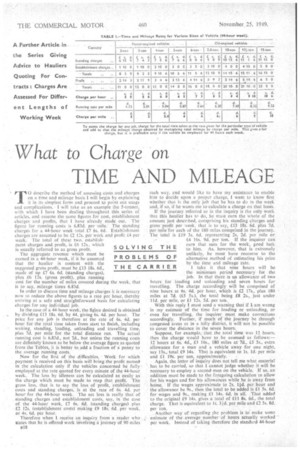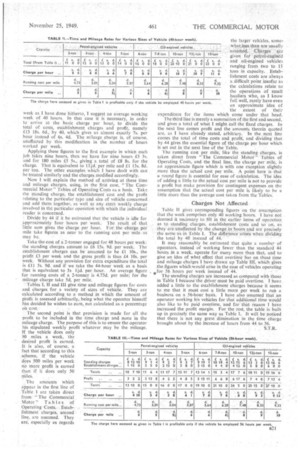0 describe the method Of assessing eCists and charges on a time and mileage basis 1 will begin by explaining
Page 52

Page 55

If you've noticed an error in this article please click here to report it so we can fix it.
r it in its simplest form and proceed to point out snags and complications, 1 will take as an example the 5-tonner, with which 1 have been dealing throughout this series of articles, and assume the same figures for cost, establishment charges and profits, that I have already made out. The figure for running costs is 6.83d. per -mile. The standing charges for a 44-hour weektotal £7 6s. 6d. Establishment charges are assumed to be £2 12s. per week and profit £4 per week. The total of these two. establishment charges and profit, is £6 12s.. which is usually referred to as gross profit.
The aggregate revenue which must be earned in a 44-hour week, if it he assumed that the haulier is content with the
suggested gross profit, must be £13 18s. 6d., THE C made of up £7 6s. 6d. (standing charges),
plus £6 12s. (gross profit), plus running cost for the number of miles covered during the week, that is to say, mileage times 6.83d.
In order to discuss time and mileage charges it is necessary now to reduce the above figures to, a rate per hour, thereby arriving at a safe and straightforward basis for calculating charges for any individual job.
in the case of a 44-hour week, the figke desired is obtained by dividing £13 18s. 6d. by 44, giving 6. 4d. per hour. The price for any job is therefore at the rate of 6s. 4d. per hour for the total time taken from start to finish, including wailing, standing, loading, unloading and travelling time, plus 7d. per mile for the total distance run. The actual running cost is 6.83d., not 7d., but unless the running costs are definitely known to be below the average figure as quoted from the Tables, it is better to add a fraction of a penny to the average running. costs. Now for the first of the difficulties. Work for which payment is received on this basis will bring the profit named in, the calculation only if the vehicles concerned be fully employed at the rate quoted for every minute of the 44-hour week. The loss. by idleness can be calculated as easily as the charge which must be made to reap that profit. The gross loss, that is to say the loss of profit, establishment costs and standing charges, is at the rate of 6s. 4d. per hourfor the 44-hour week. The net loss is really that of . standing charges and establishmerit costs. say, in the case of the 44-hour week, £7 6s. 6d. (standing charges) plus £2 12s. (establishment costs). Making £9 18s ..6d. per week, or 45. 6d. Per hour.
Therefore when I receive an inquiry from a reader who states that he is offered work involving a joUrney of 90 miles
PRO BLE
each way, and would like to have my assistance to enable him to decide upon a proper charge, I want to know first whether that is the only jobthat he has to do in the week arid, if so, if he wants me to calculate a charge on that basis.
If the journey referred to in the inquiry is the only work that this haulier has to do, he must earn the whole of the amount just descrthed, comprising his standing charges and gross -profit per week, that is to say, £13 18s. 6d. plus 7d. per mile for each of the 180 miles comprised in the journey. The total is £19 3s. fid. representing 2s. 2d. per inile or
£4 16s, 9d. per ton. If the inquirer can earn that sum for the work, good luck to him. As, however, that is extremely unlikely, he must have recourse to the alternative .method of estimating his price by the time and mileage rate.
the minimum period necessary for the job. In that there is an allowance of two hours for loading and unloading and seven hours for travelling. The charge accordingly will be comprised of nine hours at 6s. 4d. per hour, which is 12 17s., plus 180 • miles at 7d. (£5 5s.), the total being £8 2s., Just under 11d, per mile, or £1 12s. 5d. per ton.
With this reply I must send a warning that if lam wrong in my estimate of the time for loading or unloading, or even for travelling, the inquirer must make corrections accordingly. Further, if much of the journey be through congested areas or in a hilly district, it will not he possible to cover the distance in the seven hours.
Suppose, for example, that the total time was 12 hours, then the charge would have to be assessed Els follows:_ 12 hours at 6s. 4d., £3 16s., 180 miles at Td., £5 Si. extra allowance for a Man and a vehicle away for one night, say 13s., total £9 14s. That is equivalent to Is. Id. per mile and £1 196. per ton, approximately.
Again, the letter of inquiry does not tell me what rnater!al has to he carried, so that 1 cannot judge whether it will be necessary to employ a second man on the vehicle, If so, an addition must be made to the foregoing calculation to allow for his wages and for his allowLinces while he is away from hoine. If the wages approximate to 2s. lfd. per hour and the allowance be 9s., then the total to be added is £1 5s. 6d. for wages and 9s„ making £1 14s. fid. in all. That added to the original £9 14s. gives a total of £11 8s. 6d., the total charge. That is equivalent to Is. 3id, per mile and £2 5s. 8d. per ton. . Another way of regarding the problem is to make some estimate of the .average number ofhours actually worked per week. Instead of taking therefore the standard 44-hour week as I have done hitherto, T suggest an average working week of 40 hours. In that case it is necessary, in order to arrive at the basic charge per hour, to divide the total of costs, establishment charges and profit, namely £13 18s. 6d., by 40, which gives us almost exactly 7s. per hour instead of 6s. 4d. The mileage charge is. of course, unaffected by this modification in the number of hours worked per week.
Applying these figures to the first example in which each job takes nine hours, then we have for nine hours £3 3s. and for 180 miles £5 5s., giving a total of £8 8s. for the charge. That is equivalent to 1 1 id. per mile and £1 13s. 8d. per ton. The other examples which I have dealt with can be treated similarly and the charges modified accordingly.
Now I will explain the method of arriving at these time and mileage charges, using, in the first case. The Commercial Motor" Tables of Operating Costs as a basis. Take the standing charge, the establishment cost and the profit relating to the particular type and size of vehicle concerned and add them together, as well as any extra weekly charge involved in the particular operation with which the individual reader is concerned.
Divide by 44 if it be estimated that the vehicle is idle for approximately four hours per week. The result of that little sum gives the charge per hour. For the charge.. per mile take figures as near to the running ccist per mile .as may be.
Take the cost of a 2-tonner engaged for 48 hours per week: the standing charges amount to £6 15s. 9d. per week. The establishment charges can be assumed to be it 10s., the profit £3 per week and the gross profit is thus £4 10s. per week. Without any provision for extra expenditure the total is £11 5s. 9d. and if we take the 44-hour week as a basis that is equivalent to 5s lid. per hour. An average figure for running costs of a 2-tonner is 4.73d. per mile; for the mileage charge take 5d.. per mile.
" Tables I, II and HI give time and mileage figures for costs and charges for a variety of sizes of vehicle. They are calculated according to a method in which the amount of profit is assessed arbitrarily, being what the operator himself has decided he wishes to earn, not calculated as a percentage on cost.
The amounts which appear in the first line of Table I are taken direct from• "The Commercial Motor" Tables of Operating Costs. Estab lishment charges, second line, are assumed. They are, especially as regards
the larger vehicles, somewhat less than are usual] assumed. Charges ate given for petrol-engined and oil-engined vehicles ranging from two to 15 tons in capacity. Establishment costs are always a difficult point insofar as the calcUlations relate to the operations of small hauliers who, as I know
full well, rarely have even an approximate idea of the extent of their expenditure for the items which come under that head. The third line is merely a summation of the first and second, and gives a total of what I Might call the fixed charges. In the next line comes profit and the amounts therein quoted are, as I have already stated, arbitrary. In the .next line comes the total of time costs and profit, and dividing that by 44 gives the essential figure of the charge per hour which is set out in the next line of the Table.
The running cost per mile, like the standing charges, is taken direct from "The Commercial Motor " Tables of Operating Costs, and the final line, the charge per mile, is an approximate figure which is with one exception slightly more than the actual cost per mile. A point here is that a round figure is essential for ease of calculation. The idea of adding a little to the actual cost per mile is not to provide a profit but make provision for contingent expenses on the assumption that the actual cost per mile is likely to be a little more than the average cost taken from the Tables.
Charges Not Affected . Table 11 gives corresponding figures on the assumption that the week comprises only 40 working hours. I have not deemed it necessary to fill in the earlier items of Operation as to standing charges, establishment costs and So. on as they are-unaffected by the change in •liotirs and are precisely the same as in Table I. The difference irises: When dividing the total by 40 instead of 44.
It may reasonably. be estimated that quite a number of operators, instead of working fewer than the standard 44 hours in a week, operate far many more than that, and to give art idea of what effect that overtime has on these time and mileage charges I have drawn up Table III, which gives .the figures which!would arise in the case of vehicles operating -, •for. 56 hours per week instead of 44. Thestanding charges are increased as cOrnparecl with those in Table I because the driver must be paid Overtime: I have added a little to the establishment charges because it seems to me that it must cost a little more per week to run a business on a 56-hour basis. I have also assumed that an operator working his vehicles for that additional tittle would also like to be paid overtime, and for that reason I have increased the profit margin. For the rest, the table is built up in precisely the same way as Table 1, It will be noticed that there is not any great 'diminution in the time charge brought about by the increase of hours from 44. to 56.




















































































